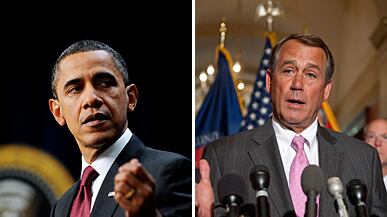Tax Day is nobody’s idea of a good time. But get ready for a year of heated tax debates ahead.
In his deficit speech last week, President Obama made clear that he intends to continue his fight to raise the top rate back up to 39.6 percent for any family making over $250,000 a year—arguing this would, in effect, be a millionaires tax. “I don't need another tax cut,” the president said. “ Warren Buffett doesn't need another tax cut.”
Obama was right to start a discussion about the growing wealth disparity in America. The New York Times reported last week that the average CEO salary is now $9.6 million. As a point of contrast, the average salary for a family of four remains stuck below $50,000. America’s great middle class has been getting squeezed for decades. We do have a problem with increasing wealth disparity in this nation, and it's not socialistic to say so.
But the top rate for taxes now kicks in at $250,000 per household. That can mean two full-time working parents making $125,000 per year—hardly high-flying in many areas of the nation. When the president compares households where both parents make $125,000 a year to Warren Buffet and himself, it’s slightly offensive and significantly out of touch. It's bad politics and bad policy.
A smarter option would be to recognize the increasing wealth disparity in America and adjust the top rate accordingly—raising it to $500,000 or even $1 million per year per household. This would match the Democrats’ “millionaires” rhetoric with reality. It would also be politically impossible for Republicans to oppose at a time when we need to pay down our deficit and our debt.
More importantly, it would make a useful distinction between today’s “super rich” and what might be called the “working wealthy.” These hard-working strivers are not living the lives of the rich and famous. They are not kings of high finance or CEOs. They are small business owners or mid-level managers. In many regions, they might still find themselves struggling to stay in the stability of the upper-middle class in the expensive urban and suburban areas where they often work.
We do have a problem with increasing wealth disparity in this nation, and it's not socialistic to say so.

The working wealthy aren't suffering in any objective sense, but they feel forgotten—like they are paying most of the taxes and getting few of the benefits in terms of direct government assistance. They are makers, not takers. And let’s not forget that small businesses create 70 percent of the jobs in this country.
While the super-rich search for charitable donations to reduce their overall tax burden, the working wealthy are still trying to pay their bills, particularly if they have kids still at home or in college. But they are taxed at the same rate as the private jet set.
Here’s another reality check to add to the argument: The $250,000 per household top-rate hasn’t been adjusted for inflation since it was first instituted in 1993. If you adjust it for inflation over the past 18 years, the top rate would now be $377,000—a more rational cut-off point for a home with two working parents.
During the last debate about extending the Bush-era tax cuts for the wealthy, New York Senator Chuck Schumer floated this same $1 million top-rate proposal as a compromise. Others argued that $500,000 made more sense as a cut-off point for raising rates.
This reframing of the debate was a good idea then and remains a good idea now—especially as we enter a presidential campaign. It’s honest, transparent, and infinitely preferable to watching another season of politicians slobbering over the super-rich for donations at night while pandering to voters with false populism during the day.
For my money, the smartest way to approach the need for revenue increases as we focus on reducing the deficit and the debt would be for the administration and Senate Democrats to work with Republicans on fundamental tax reform—simplifying the system and closing loopholes. This is something that Austan Goolsbee, chair of Obama’s Council on Economic Advisers, discussed repeatedly during the 2008 campaign and which Paul Ryan calls for in his “Path to Prosperity,” the GOP’s budget blueprint. There is a potential for a grand bargain.
Those prospects haven’t been helped by the tone of economic debates in our hyper-partisan times. For example, the debate about returning to the top tax rate under Clinton has been distorted to the point where it feels to some like a tipping point toward socialism or communism. This is fear-mongering nonsense. Tax rates should be matters of math, not ideology.
At a time when the average CEO salary is $9.6 million—190 times what the average family of four makes—and while unemployment remains stuck at 8 percent, there is some room to maneuver in ways that reduce rather than increase economic hardship across our society.
But raising the top rate on two people making $125,000 does not reflect today’s economic reality. Lumping them in with the super-rich is absurd and unfair. It will provoke a political backlash and possibly delay the economic recovery.
Raising the top rate to be an actual millionaire’s tax is a fight that the president can win—eroding rational opposition and while helping to reduce the deficit and the debt.
John Avlon's most recent book Wingnuts: How the Lunatic Fringe is Hijacking America is available now by Beast Books both on the Web and in paperback. He is also the author of Independent Nation: How Centrists Can Change American Politics and a CNN contributor. Previously, he served as chief speechwriter for New York City Mayor Rudy Giuliani and was a columnist and associate editor for The New York Sun.






